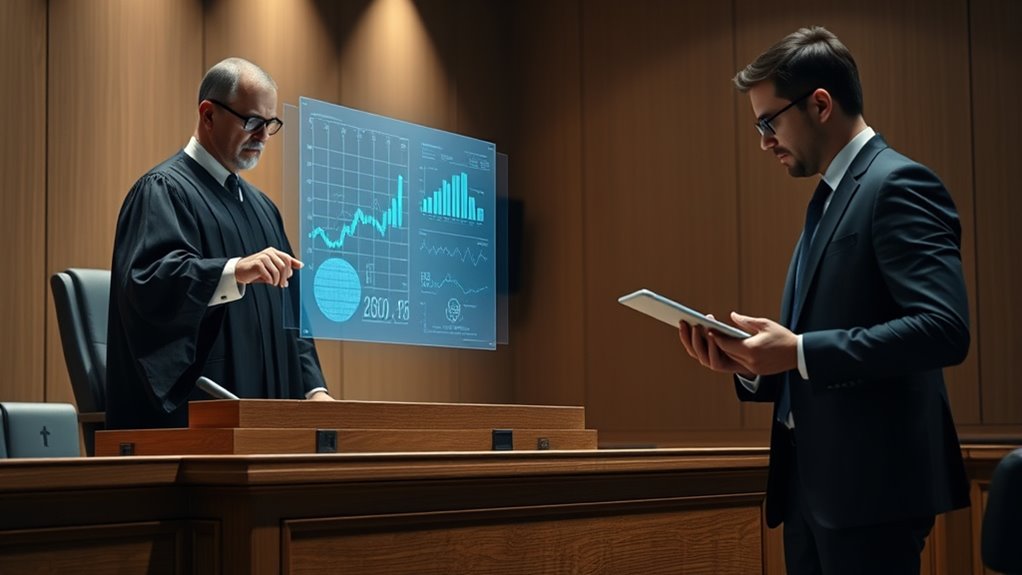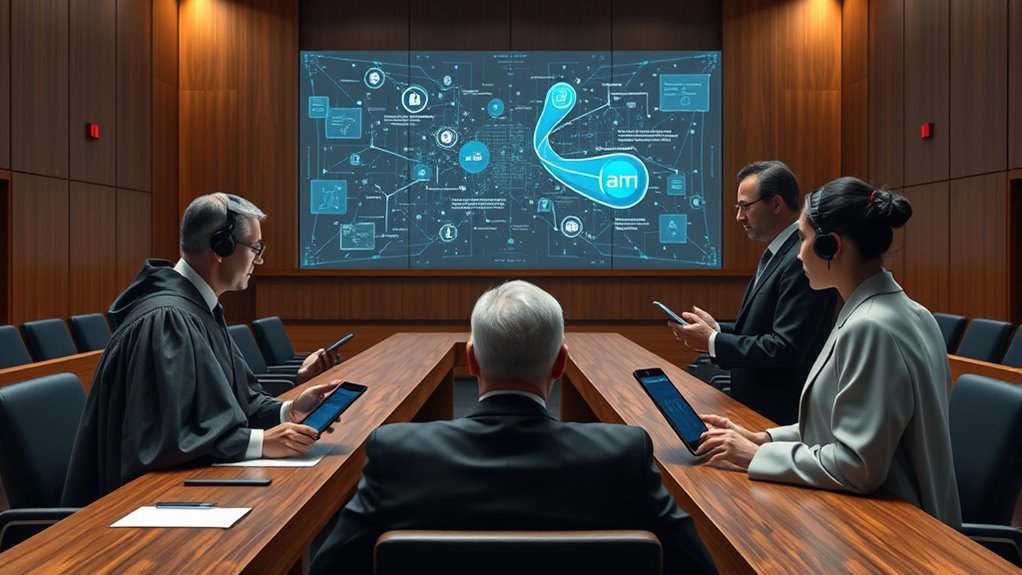AI virtual assistants are increasingly transforming courtrooms by automating routine tasks like legal research, document review, and case summaries, helping judges and lawyers save time and reduce errors. They also improve access to justice through virtual hearings and chatbots that offer immediate legal guidance. Despite challenges like limited resources and ethical concerns, AI’s potential to boost efficiency and fairness is growing. If you continue exploring, you’ll discover how these tools can shape the future of justice.
Key Takeaways
- Virtual assistants automate routine tasks like legal research, document review, and case summarization, improving efficiency for judges and lawyers.
- AI-powered tools provide instant legal guidance and predictive analytics to support informed decision-making in court proceedings.
- Virtual assistants help manage scheduling, deadlines, and client inquiries, streamlining courtroom workflows and reducing delays.
- Ethical and legal considerations include ensuring transparency, fairness, and accountability in AI-driven judicial processes.
- Adoption barriers include resource limitations, technological gaps, and concerns over bias and data security.
Current State of AI Adoption in Judicial Settings

Although AI has the potential to transform judicial operations, its adoption remains limited across U.S. courts. Only about 17% of state courts currently use generative AI technologies, despite staffing shortages and increasing caseload complexity. Most courts remain cautious, with 70% not allowing employees to utilize AI tools for court business. While virtual hearings are widely implemented—about 80% participation—they mainly improve access and efficiency rather than AI integration. Court professionals recognize AI’s high impact potential, with 55% viewing it as a transformative trend, but many remain hesitant due to budget constraints, technological gaps, and concerns about ethical implications. Overall, AI’s role in courts is evolving slowly, constrained by practical and regulatory challenges. The limited adoption of AI also reflects ongoing concerns about technology integration, and the need for clear guidelines to ensure responsible use. Additionally, the rapid development of automation technologies in other sectors underscores the importance of establishing robust standards for AI in judicial settings. As courts explore these innovations, understanding related technological advancements can help in designing more effective AI deployment strategies. Furthermore, ongoing research into AI vulnerabilities highlights the necessity for implementing safety measures to prevent misuse and ensure trustworthiness. Recognizing the importance of cybersecurity vulnerabilities in protecting sensitive judicial data is crucial as AI tools become more prevalent.
How Virtual Assistants Improve Legal Workflow Efficiency

Virtual assistants are transforming legal workflows by automating routine tasks that traditionally consume significant time and resources. You’ll find that they handle document review, legal research, and case summarization quickly and accurately, freeing you to focus on strategic work. These assistants can categorize legal information by jurisdiction or relevance, speeding up case preparation. They also streamline contract analysis, reducing manual effort and minimizing errors. By managing scheduling, deadlines, and client inquiries, virtual assistants keep your workflow organized and efficient. This automation reduces turnaround times and helps you meet tight deadlines. In addition, integrating AI-powered tools can enhance predictive analytics, enabling more informed decision-making in your legal strategies. Staying updated on legal technology trends ensures you leverage the latest innovations for maximum benefit. Using AI-powered virtual assistants can also improve compliance monitoring and risk assessment, further supporting your legal operations. As a result, you can serve clients faster, reduce workload stress, and improve overall productivity. Incorporating legal resource management tools can help streamline case information and prioritize tasks effectively. Virtual assistants become essential tools that enhance efficiency without sacrificing quality or accuracy.
Enhancing Justice and Accessibility Through AI Tools

AI tools are expanding their role beyond streamlining workflows to fundamentally improve justice and access in the courtroom. You can now leverage virtual assistants and chatbots to provide immediate legal guidance, making legal help more affordable and reachable for those who face barriers. Cultural Intelligence Virtual hearings allow litigants to participate without missing work or caregiving duties, fostering inclusivity. AI-driven case management enhances efficiency while ensuring fairness by reducing missed appearances and delays. Additionally, AI can predict judicial outcomes and suggest innovative legal arguments, helping to level the playing field for all parties. By increasing transparency, reducing costs, and broadening access, AI tools empower courts and legal professionals to deliver more equitable justice, ultimately making the legal system more responsive to everyone’s needs. Incorporating personality insights can further improve communication and fairness by understanding individual stakeholder needs. Innovative dispute resolution methods are also being supported by AI to facilitate faster and more amicable outcomes. As AI technologies continue to evolve, they hold the potential to revolutionize drug discovery processes, leading to faster development of new legal and procedural frameworks that adapt to emerging innovations.
Overcoming Challenges in Implementing AI in Courts

Implementing AI in courts faces significant hurdles like limited budgets and resource gaps that slow adoption. You also need to navigate complex ethical and legal concerns around transparency, bias, and accountability. Addressing these issues is essential to safely and effectively integrate AI into judicial processes.
Budget and Resource Barriers
Despite the clear benefits, courts face significant budget and resource barriers that hinder widespread AI adoption. Many courts lack the funding to invest in advanced technologies or upgrade existing infrastructure. Implementing AI tools requires substantial upfront costs, including software, hardware, and staff training, which many jurisdictions cannot afford. Limited budgets also restrict ongoing maintenance and updates, risking technology obsolescence. Additionally, resource constraints mean courts often lack dedicated personnel to evaluate, integrate, and support AI systems effectively. Without dedicated funds and staffing, scaling AI solutions across courts remains challenging. This financial and resource scarcity slows progress and creates disparities between jurisdictions, making it difficult to realize AI’s full potential to improve efficiency and access to justice. Furthermore, understanding sound healing science and integrating holistic approaches could offer alternative pathways to improve court environments and staff well-being. For instance, incorporating holistic health practices may help mitigate stress and enhance productivity among court personnel. In such cases, fostering a collaborative environment can promote better implementation and acceptance of new technologies. For example, creative practice can be used to develop innovative solutions that optimize limited resources and foster resilience among court personnel. Recognizing the importance of technological infrastructure is crucial for future progress and equitable implementation.
Ethical and Legal Concerns
As courts consider adopting AI technologies, they face significant ethical and legal concerns that can hinder progress. You must address transparency issues, ensuring AI decisions are explainable and understandable to all parties. Bias in algorithms raises questions about fairness, risking unjust outcomes and eroding trust. Accountability becomes complex when determining responsibility for AI errors or biases, especially in sensitive decisions. Privacy protections are essential, as AI systems process vast amounts of personal data, raising risks of misuse or breaches. Additionally, legal frameworks lag behind technological advances, leaving unclear how AI-driven decisions fit within existing law. Balancing innovation with these ethical and legal challenges requires careful oversight, clear guidelines, and ongoing evaluation to prevent harm and maintain public confidence in the justice system. Incorporating transparency and fairness into legal decisions is an emerging area, highlighting the importance of algorithmic accountability and the need for robust oversight mechanisms. Addressing these issues also involves developing ethical standards that guide responsible AI deployment in judicial contexts.
The Transformative Impact of AI on Legal Practice

AI is revolutionizing legal practice by boosting efficiency and precision in case work. It helps shape strategies through predictive analytics and data-driven insights, giving you a competitive edge. As a result, you can focus more on high-value tasks while AI handles routine and complex processes. Incorporating efficient storage solutions can further streamline case management and documentation. Additionally, understanding appliance maintenance plans can support the development of reliable digital tools and systems used in legal workflows.
Enhancing Efficiency and Accuracy
The integration of AI into legal practice considerably boosts efficiency and accuracy by automating routine tasks and providing deeper insights. You can delegate document review, case summarization, and legal research to AI virtual assistants, drastically reducing turnaround times and minimizing human error. AI tools can categorize legal information by jurisdiction, relevance, or argument strength, enabling you to prepare cases with greater precision and speed. This automation frees you to focus on strategic, high-value activities, improving overall productivity. Additionally, AI-driven data analysis helps identify patterns and predict outcomes, guiding your decision-making with more confidence. Combining AI assistance with your expertise ensures you handle complex cases more precisely and efficiently, ultimately delivering faster, more reliable results to clients.
Shaping Legal Strategies
By automating routine tasks and providing deeper insights, AI has already transformed legal work efficiency and accuracy. You can leverage AI to develop smarter legal strategies by:
- Utilizing predictive analytics to assess case outcomes, helping you craft more effective arguments.
- Analyzing vast legal data to identify patterns and precedents that support your position.
- Generating tailored legal arguments and proposals based on real-time data, giving you a strategic edge.
These tools enable you to evaluate risks, optimize case strategies, and anticipate opposing arguments with greater precision. AI’s ability to process complex information quickly means you can make more informed decisions faster, ultimately strengthening your case and improving your chances of success.
Future Directions and Strategic Considerations for AI in Courts

As courts consider future directions, strategic planning around AI adoption becomes essential to maximize benefits and mitigate risks. You need to evaluate AI’s potential to improve efficiency, access, and fairness, while addressing ethical, legal, and operational challenges. Prioritize developing clear implementation strategies, training programs, and transparency measures. Focus on AI as an augmentative tool that supports human judgment, rather than replacing it. Consider the following table to guide your planning:
| Focus Area | Key Considerations | Action Steps |
|---|---|---|
| Ethical Use | Bias, transparency, accountability | Establish guidelines and oversight |
| Training & Adoption | Workforce readiness and workflow | Provide targeted education |
| Legal Framework | Regulations and legal standards | Develop policies for AI use |
| Infrastructure | Technology gaps and budget | Invest in scalable, secure systems |
| Impact Assessment | Measuring AI benefits and risks | Regular evaluations and updates |
Frequently Asked Questions
How Do Courts Ensure AI Tools Are Unbiased and Ethically Sound?
You guarantee AI tools are unbiased and ethically sound by implementing rigorous testing and ongoing monitoring for bias, transparency, and fairness. You require developers to follow ethical guidelines, use diverse data sets, and conduct regular audits. You also promote accountability by documenting AI decision processes and encouraging human oversight. By fostering collaboration among legal professionals, technologists, and ethicists, you can better address risks and uphold justice standards.
What Training Is Needed for Judges and Lawyers to Effectively Use AI Tools?
You’ll need training that’s more than just a quick click-through. Think in-depth workshops on AI capabilities, limitations, and ethical pitfalls, plus hands-on practice to build confidence. Expect to learn how to interpret AI outputs critically, understand bias risks, and integrate these tools seamlessly into your workflow. Continuous education is key, because if you think you can just press “update” and be an AI expert, you’re in for a surprise.
How Does AI Impact the Privacy and Security of Court Data?
AI impacts court data privacy and security by increasing risks of breaches and unauthorized access. You need to implement robust encryption, access controls, and regular security audits to protect sensitive information. Be cautious about data-sharing practices with third parties and ensure compliance with legal standards like GDPR or HIPAA. Staying vigilant and updating security protocols regularly helps prevent cyber threats, safeguarding the integrity and confidentiality of court data.
What Are the Legal Liabilities if AI Makes an Error in Court Proceedings?
If AI makes an error in court proceedings, it’s like a domino toppling over—liability depends on who controls and oversees the technology. You might be held responsible if you rely too heavily on AI without verifying its outputs. Courts could face legal challenges, especially if mistakes lead to wrongful decisions. Clear guidelines and accountability measures are essential to shield you from potential liability, ensuring justice isn’t left to chance.
How Will AI Integration Affect the Traditional Roles of Judges and Legal Practitioners?
AI integration will shift your traditional roles by automating routine tasks, freeing you to focus on complex case analysis and strategic decision-making. You’ll rely more on AI for research, data analysis, and case management, but human judgment remains vital for fairness and ethics. As a judge or lawyer, you’ll need to adapt by developing new skills, overseeing AI outputs, and ensuring that technology enhances, not replaces, your core responsibilities.
Conclusion
Just like a steady lighthouse guiding ships through foggy waters, AI in the courtroom illuminates new paths for justice. Embracing virtual assistants can streamline your legal workflow, enhance accessibility, and transform your practice. While challenges exist, staying proactive and strategic guarantees you’re part of this exciting evolution. Don’t let the future pass you by—embrace AI now and lead the way toward a more efficient, fair, and accessible justice system.









